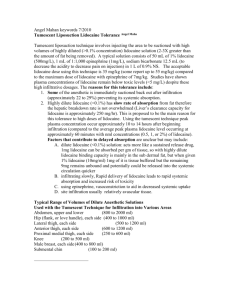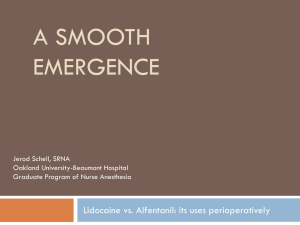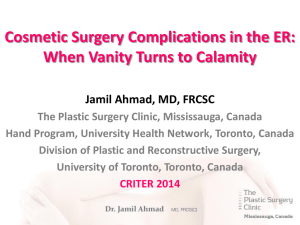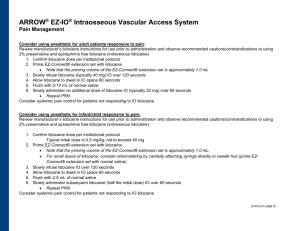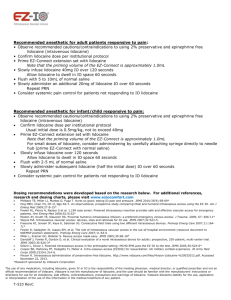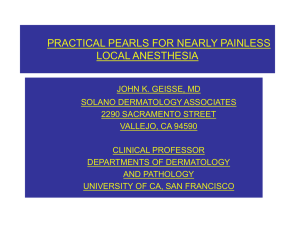Table IV: Effects of lidocaine and placebo on the - HAL
advertisement
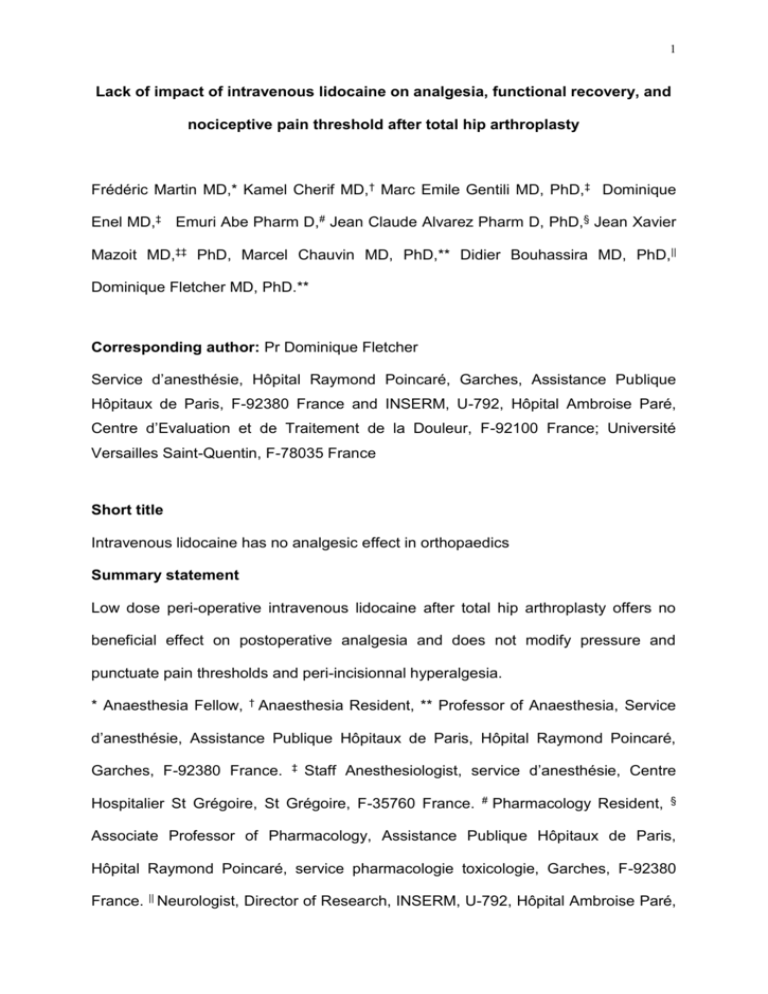
1 Lack of impact of intravenous lidocaine on analgesia, functional recovery, and nociceptive pain threshold after total hip arthroplasty Frédéric Martin MD,* Kamel Cherif MD,† Marc Emile Gentili MD, PhD,‡ Dominique Enel MD,‡ Emuri Abe Pharm D,# Jean Claude Alvarez Pharm D, PhD,§ Jean Xavier Mazoit MD,‡‡ PhD, Marcel Chauvin MD, PhD,** Didier Bouhassira MD, PhD,|| Dominique Fletcher MD, PhD.** Corresponding author: Pr Dominique Fletcher Service d’anesthésie, Hôpital Raymond Poincaré, Garches, Assistance Publique Hôpitaux de Paris, F-92380 France and INSERM, U-792, Hôpital Ambroise Paré, Centre d’Evaluation et de Traitement de la Douleur, F-92100 France; Université Versailles Saint-Quentin, F-78035 France Short title Intravenous lidocaine has no analgesic effect in orthopaedics Summary statement Low dose peri-operative intravenous lidocaine after total hip arthroplasty offers no beneficial effect on postoperative analgesia and does not modify pressure and punctuate pain thresholds and peri-incisionnal hyperalgesia. * Anaesthesia Fellow, † Anaesthesia Resident, ** Professor of Anaesthesia, Service d’anesthésie, Assistance Publique Hôpitaux de Paris, Hôpital Raymond Poincaré, Garches, F-92380 France. ‡ Staff Anesthesiologist, service d’anesthésie, Centre Hospitalier St Grégoire, St Grégoire, F-35760 France. # Pharmacology Resident, § Associate Professor of Pharmacology, Assistance Publique Hôpitaux de Paris, Hôpital Raymond Poincaré, service pharmacologie toxicologie, Garches, F-92380 France. || Neurologist, Director of Research, INSERM, U-792, Hôpital Ambroise Paré, 2 Centre d’Evaluation et de Traitement de la Douleur, F-92100 France; Université Versailles Saint-Quentin, Versailles, F-78035 France. ‡‡ Université Paris-Sud, laboratoire d'anesthésie, UPRES EA3540 Faculté de Médecine, F-94275, Le Kremlin-Bicêtre, France Financial support : support was provided solely from institutional and/or departmental sources. 3 Abstract (246 words) Background: The analgesic effect of perioperative low doses intravenous lidocaine has been demonstrated after abdominal surgery. This study aimed to evaluate whether a continuous intravenous (IV) low-dose lidocaine infusion reduced postoperative pain and modified nociceptive pain threshold after total hip arthroplasty. Methods: Sixty patients participated in this randomised double-blinded study. Thirty patients received lidocaine 1% (lido group) with a 1.5 mg.kg-1 IV bolus in 10 min followed by a 1.5 mg.kg-1.h-1 IV infusion and other patients received saline (control group). These regimens were started 30 min before surgical incision and stopped one hour after skin closure. Lidocaine blood concentrations were measured at the end of administration. In both groups, postoperative analgesia was provided exclusively by patient-controlled IV morphine. Pain scores, morphine consumption, operative hip flexion were recorded over 48 h. In addition, pressure pain thresholds and the extent of hyperalgesia around surgical incision were systematically measured at 24 and 48h. Results: In comparison with the placebo, lidocaine did not induce any opioid-sparing effect during the first 24 hours (- 2 mg with 95 CI [-5; 9]; p = 0.55). There was no significant difference regarding the effects of lidocaine and placebo on pain score, pressure pain thresholds, extent in the area of hyperalgesia, and maximal degree of active hip flexion tolerated. Mean plasma lidocaine concentration was 2,1 ± 0,4 g/ml. Conclusion: Low dose perioperative IV lidocaine after total hip arthroplasty offers no beneficial effect on postoperative analgesia and does not modify pressure and tactile pain thresholds. 4 Introduction Patients experience moderate to severe pain after total hip arthroplasty. Adequate control of postoperative pain facilitates earlier mobilisation and rehabilitation. Patientcontrolled analgesia is effective to treat pain at rest but seems to be inadequate for dynamic analgesia and may also elicit side-effects that may delay hospital discharge. In addition, recent data suggest that extensive use of opioids is associated with hyperalgesia and allodynia.1 Thus, in order to reduce opioid consumption and because acute pain is mediated by activation of numerous biochemical and anatomical pathways, practitioners are turning to alternatives to systemic opioids leading to balanced analgesia concept.2 Among co-analgesics which have been recently studied for the postoperative pain treatment, systemic administration of local anesthetics has been shown to have both analgesic 3-5 and antihyperalgesic actions.6 Analgesic action has been suggested to result both of a specific peripheral blockade of ectopic discharges in neurones involved in nociception 7 and a direct action on spinal transmission in the spinal cord.8 Moreover, lidocaine has significative anti-inflammatory properties 9 blocking neutrophil accumulation at the injury site and decreasing the release of inflammatory mediators.10 Recent clinical studies demonstrated an morphine-sparing effect of intravenous lidocaine after major abdominal surgery. Among beneficial effects of lidocaine, authors reported a faster return of bowel function,11,12 an improved dynamic analgesia and a reduced hospital stay.4,12,13 Most trials have been carried out after major urologic or abdominal surgery. There is no data about systemic lidocaine effect after orthopaedic surgery. 5 The aim of the present randomized, double-blind, placebo-controlled study was to evaluate the analgesic effect of continuous IV lidocaine after total hip arthroplasty and analyze its effects on peri-incisional mechanical hyperalgesia. 6 Material and Methods After approval of the Local Ethics Committee (Comité de Protection des Personnes pour la Recherche Biomédicale, hôpital Ambroise Paré Boulogne 92) and patient’s informed consent, a prospective bicentre randomised double-blinded study including patients undergoing total hip arthroplasty was undertaken. American Society of Anesthesiologists physical status I-III patients between 18 and 80 years scheduled for hip arthroplasty under general anesthesia were included. Exclusion criteria were anterior surgical approach, regional anesthesia, contraindications for lidocaïne or morphine use, severe cardiac, renal or hepatic diseases, and preoperative use of analgesics (corticosteroids, opioid). We chose as primary endpoint the morphine consumption over the initial 24 postoperative hours. A clinically significant morphine-sparing effect was considered to be 15 mg over 24 h. According to previous data (SD: 19) 14 for risk of 0.05 with a power of 80%, we calculated that it was necessary to include at least 25 patients per group. Thus, it was decided to include 60 patients to account for drop-outs. The study began in January 2006 and ended March 2007. Protocol Before the study began a randomisation list, balanced by centre, was established and each centre enrolled patients and assigned treatments consecutively. For each patient, an envelope containing the group assignment was prepared, sealed, and sequentially numbered. On the morning of surgery and before induction of anesthesia, a “blinded” nurse prepared lidocaine or saline solution syringes. None of the other investigators involved in patient management or data collection were aware of the 7 group assignment. Patients scheduled to receive lidocaine 10 mg/ml (lido group) were given an intravenous bolus injection of 1.5 mg/kg of lidocaine in 10 min (30 min before surgical incision) followed by a continuous IV infusion of 1.5 mg/kg/h. The infusion ended 60 min after skin closure. In the control group patients were given equal volumes of saline. Anaesthesia Patients were premedicated with 1-2 mg/kg hydroxyzine orally 2 h before anaesthesia. General anaesthesia was induced with 0.2 g/kg sufentanil followed by 5 mg/kg thiopental and 0.5 mg/kg atracurium to facilitate orotracheal intubation. Then, patients were ventilated to normocapnia with 50% oxygen and without nitrous oxide. Anaesthesia was maintained with sufentanil (0.2 g/kg/h) and sevoflurane at an initial end-tidal concentration of 1 minimum alveolar concentration, adjusted to age. Inspired sevoflurane concentration was fixed and sufentanil infusion was adjusted to maintain heart rate within 15% of the preinduction value and systolic arterial blood pressure within 20% of the baseline value (step of ± 0.05 g/kg/h). Sufentanil was stopped thirty minutes before end of surgery. Patient’s trachea was extubated when response to verbal commands, spontaneous respiratory rate exceeding 12 breaths / min (bpm) and end-tidal carbon dioxide partial pressure less than 45 mm Hg were observed. Patients were admitted to the post-anaesthesia care unit (PACU) within 5 min of tracheal extubation. In the PACU, patients were asked to report any lidocaine toxicity side effects such as light headedness, drowsiness, metal taste, perioral numbness, and visual disturbances. 8 Postoperative analgesia Postoperative analgesia was provided in both groups only with IV patient controlled morphine. No others co-analgesic were prescribed. Upon arrival in the PACU, pain was evaluated every 5 min using a four-point verbal rating scale for pain (0 : no pain, 1 : slight pain, 2 : moderate pain, 3 : intense or severe pain). If the score was >2, patients under 65 years received morphine 3 mg while older patients were given 2 mg, every 5 min, if permitted according to the respiration rate (RR > 10 bpm) and sedation score (score < 1), until a verbal rating scale score of 0 or 1 had been achieved. The sedation score was as follows: 0 = no sedation; 1 = intermittent drowsiness; 2 = patient drowsy but could be aroused verbally; 3 = impossible to arouse the patient verbally. Once a verbal rating scale < 1 had been achieved, spontaneously or after a loading dose of morphine, patients were connected to a patient-controlled analgesia device set to deliver 1 mg morphine as an intravenous bolus with a 5-min lockout interval; continuous infusion was not allowed. Patient-controlled analgesia was stopped in both groups at the 48th hour, and further analgesia was provided by combination of paracetamol, nonsteroidal antiinflammatory drugs and subcutaneous morphine as needed. Evaluation The cumulative dose of morphine given postoperatively (titration and patientcontrolled analgesia during the 24-h and 48-h observation period) was measured as were the 100-mm visual analog scale pain score (0 : no pain to 100 : worst possible pain) and the verbal rating scale pain score. Both scores were monitored at rest and 9 during hip flexion. The hip flexion angle was also evaluated during the hospitalisation and at the 3rd post-surgical month. During the preoperative anesthetic evaluation, patients were instructed in the use of quantitative sensory tests (punctuate and pressure pain detection thresholds). These measurements were performed in the morning of the first (D1) and the second day (D2) after surgery. The punctuate pain detection threshold for mechanical static stimuli was assessed using calibrated von Frey hairs (0.057–178 g/mm2). The patients were instructed to close their eyes during the procedure. Care was taken to avoid stroking the skin with the hair and to apply only a pressure stimulus. Filaments were applied to the designated point on the skin for 1 s. Von Frey hair applications were separated by at least 30 s to reduce the likelihood of anticipatory responses. The von Frey filaments were applied in ascending order of stiffness. Punctuate pain threshold was defined as the smallest force (g/mm2) necessary to bend a von Frey hair, which was just perceived as painful. Three determinations with an interval of 30 s were made during each assessment, and the pain threshold was calculated as the mean of the values obtained for the 3 measurements. A handheld electronic pressure algometer (Somedic AB, Stockholm, Sweden) with a 0.28-cm2 probe area was used to determine pressure pain detection threshold. The patients were instructed to immediately activate a push button, which freezes the digital display, when pain was perceived. The average of three measurements with an interstimulus interval of 60 s was defined as pressure pain threshold value. Values were expressed in kPa. A mean value for the three periincisional regions was calculated and used for statistical comparisons. 10 Punctuate and pressure pain thresholds were measured at 2–3 cm from the incision at three levels (top, middle, and bottom) and on the opposite thigh the day before the surgery and at the 24th and 48th hour. A mean value was calculated for statistical comparisons. The extent of mechanical hyperalgesia to von Frey hair stimulation around the surgical wound was assessed with von Frey hair No. 16 (pressure : 122 g/mm2) according to the method previously described 2,15. Hyperalgesia was determined by stimulating along three linear paths at right angles to the top, middle, and bottom sides of the surgical incision in steps of 5 mm at 1-s intervals, starting well outside the hyperalgesic area (5 cm). Stimulations continued toward the incision until patients reported a clear change in sensation (e.g., burning, tenderness, or pricking). The distance (in cm) from the incision to where sensations changed was measured, and a sum of the three assessments (top, middle, and button) was calculated and used for statistical comparisons. Blood samples were drawn at 60 min after the skin closure in the PACU to measure plasma lidocaine concentrations. Lidocaine and its active metabolite monoethylglycinexylidide were quantified in plasma using liquid chromatography iontrap mass spectrometry detection with electrospray ionisation interface, after basic liquid/liquid extraction using ropivacaine as internal standard. Data were collected in full-scan MS/MS mode, selecting the ion m/z 235.1 for lidocaine, m/z 207.1 for monoethylglycinexylidide and m/z 275.1 for ropivacaine for quantification. Retention times were 3.75, 3.05 and 5.60 min for lidocaine, monoethylglycinexylidide and ropivacaine, respectively. Calibration curves were linear in the 200-5000 ng/ml and 20-500 ng/ml ranges for lidocaine and monoethylglycinexylidide, respectively. The intra- and inter-assay precisions evaluated at 800 and 3000 ng/ml for lidocaine and 11 80 and 300 ng/ml for monoethylglycinexylidide were all <9.8%, and the intra- and inter-assay accuracies were in the 93.6-102.0% range. Stability assay after three freeze-thaw cycles has shown any significant changes of the lidocaine and monoethylglycinexylidide plasma concentrations. Statistical analysis The primary criterion was the PCA morphine consumption over 24 h. Secondary criteria were peroperative sufentanil dose, morphine given in PACU, cumulative postoperative morphine consumption at the 48th hours, visual analog scale pain score at rest and when moving, punctuate and pressure pain threshold, extend of hyperalgesia, postoperative hip flexion and duration of hospital stay. Continuous variables are presented as mean ± SD and were compared with an unpaired Student t test. Because morphine consumption has usually no Gaussian distribution, results were presented as median [25–75% interquartile range] and the Mann–Whitney test was used. The 95 % CI of the median was calculated by bootstraping the raw data with 1000 replications. Pain thresholds and the 100-mm visual analog scale pain scores for 48 h were analyzed with two-way analysis of variance for repeated measures. Categorical data were analyzed with chi-square tests. Statistical analysis was performed with Statview for Windows (version 5.0; SAS Institute Inc, Cary, NC); P < 0,05 was considered statistically significant. 12 Results Of sixty patients included, 2 were excluded in the lidocaine group. They decided to leave the study in the PACU because of extreme pain. Patient’s characteristics and operative data were comparable in the two treatment group (Table I). There were no significant differences between lido and placebo groups considering morphine requirements in the PACU (12 [8 - 20] versus 18 [12 – 20]; p= 0.32), cumulative morphine consumption over 24 postoperative hours (17 [9 - 28] versus 15 [8 – 23]; p= 0.54) and cumulative morphine consumption over 48 postoperative (43 [28 - 63] versus 46 [32 - 57]; p= 0.97) (Table II). We have also calculated the 95 CI for our primary criterion morphine consumption over 24 postoperative hours which was [1019] for lidocaine and [12-18] for placebo groups. There were no statistically significant differences between both groups for the visual analog scale pain score at rest and when moving at the 24th, the 48th hours and three months after the surgery. Preoperative hip flexion was comparable in the two groups; active hip flexion was also similar after 48 hours (control group: 83 ± 13°; lidocaine group: 81 ± 12°) and 3 months (control group: 111 ± 14°; lido group: 116 ± 11°). Duration of hospital stay was similar in both groups (Table III). One hour after skin closure corresponding to the end of IV lidocaine infusion, mean lidocaine plasma and mean monoethylglycinexylidide plasma levels were 2.1 ± 0,4 g/ml [1.5; 3.2] and 0.3 ± 0.2 g/ml [0.05; 0.64] respectively and none approached a toxic level (i.e. plasma level > 4 g/ml). No patient reported lidocaine toxicity side effects and no adverse events were reported in this group. Both groups of patient experienced hyperalgesia to von Frey hair and algometer stimulation around the surgical wound at 24 and 48 h after the operation. However, 13 punctuate and pressure pain threshold at 2–3 cm from the incision did not differ between groups (figure1). Furthermore, extent of hyperalgesia to von Frey hair stimulation proximal to the surgical incision was detected in all patients and there was no significative difference in both groups at 24 and 48 h (Table IV). Punctuate and pressure pain thresholds measured on the opposite leg did not differ preoperatively versus postoperatively in any group. 14 Discussion We did not find any significant impact of IV lidocaine on postoperative analgesia or wound hyperalgesia after total hip arthroplasty. It is unlikely that the present negative results were due to a methodological bias. A sample-size estimate indicated that 25 patients per group would give a power of 80% at an level of 0.05 for detecting a clinically significant morphine-sparing effect of 15 mg over 24 h. However, for this type of surgery, leading to only moderate morphine consumption and possibly limited central sensitization a larger sample size could point out significant morphine-sparing and antihyperalgesic effects of systemic lidocaine. This is why we performed a post hoc analysis which revealed that the confidence interval for mean morphine consumption over 24 postoperative hours was [10-19 mgr] for lidocaine group and [12-18 mgr] for placebo group suggesting that the largest detectable difference lies within bounds that are not clinically relevant. Our results on analgesia might of course differ if the infusion had been prolonged. We chose a short peri-operative protocol because this administration period had been used in most previous studies evaluating intravenous lidocaine and for safety reasons in order to avoid prolonged continuous IV lidocaine infusion with possible related inappropriate administration. Mean plasma lidocaine concentration of 2.1 g/ml, 60 min after skin closure when lidocaine infusion was discontinued, are similar to lidocaine concentration in previous studies demonstrating beneficial effect of lidocaine.3,13 However, although lidocaine concentrations lie between adequate bounds, lidocaine’s analgesic properties might depend on lidocaine dose infused too, 15 as demonstrated in animal study.16 It was shown that small doses suppress ectopic impulse generation in chronically injured peripheral nerve, whereas moderate doses suppress central sensitisation and central neuronal hyperexcitability. However, large doses have general analgesic effect but induce systemic toxicity.16 Various lidocaine infusion protocols have been used only during surgery, 4,12,18,19 intra-operatively and for 24 hours postoperatively,11,13,20-22 or exclusively after surgery with PCA.23 Only two trials using PCA associating morphine plus lidocaine peri-operative 23 22 and lidocaine administration failed to demonstrate opioid-sparing effect. The other studies reported various impacts on analgesia associated with a reduction of postoperative morphine requirement but opioid consumption was generally only one secondary endpoints (except in three studies 3,19,22). Thus, whereas patients who received intravenous lidocaine needed less morphine from the 36 th to the 72nd hours after surgery in one study,3 other reports noticed a 50 % reduction in the demand of morphine just in the PACU 4 or during the first 24 hours.13 This is the first report of the effects of intravenous lidocaine on nociceptive processing after orthopedic surgery. Most of previously published studies 4,13 have been performed during abdominal surgery using as primary criterion the accelerated postoperative recovery of bowel function. Despite a larger number of patients and an adequate lidocaine plasma levels, we did not observe an opioid-sparing effect at any time of the peri-operative period. The discrepancies with previous published studies might be explained by the type of surgery we used. Indeed, several animal reports have shown an excitatory effect of local anesthetics on intestinal smooth muscle both in vitro 24 and after systemic administration in vivo.25 These hypotheses have been confirmed in human radiological experimentation.11 Moreover, a recent animal study showed that intravenous lidocaine had inhibitory effects on viscero-motor, 16 cardiovascular reflexes and on the evoked and spontaneous activity of neurons excited by colorectal distension suggesting that sodium channel blockers might have a role in the treatment of visceral pain.26 Thus, it is plausible that part of lidocaine’s analgesic properties reported during digestive surgery was in fact indirect and related to an improvement in bowel function inducing a diminution of visceral pain. For the first time, we studied effect of lidocaine on punctuate and pressure pain detection threshold and on the extent of hyperalgesia surrounding surgical incision. This methodology has already been used in pharmacological studies in humans to investigate the analgesic and anti-hyperalgesic effects of different drugs.1,15,27 This mechanical hyperalgesia seems to share the same central neuronal mechanism as heat-induced secondary hyperalgesia confirming a degree of central sensitisation. 28 In our study, we were not able to demonstrate a reduction of secondary hyperalgesia around the surgical wound in the lido group whereas in recent human volunteer trials using the intradermal capsaicin or incision-induced pain to produce cutaneous secondary hyperalgesia, authors found a reduction of secondary hyperalgesia to von Frey hair stimulation.29-31 Our study was not powered for secondary hyperalgesia comparison and this may limit the meaning of our result. This was confirmed by a post hoc power analysis based on our results (8 cm with a SD of 6 cm) suggesting that we should have to include 47 patients/group in order to give a power of 80% at an level of 0,05 to detect a difference in 50% in the extent of hyperalgesia to von Frey hair. In summary, in contrast with previous published studies, our study did not show any benefit of the peri-operative administration of low dose of IV lidocaine in terms of postoperative analgesia and functional recovery after total hip arthroplasty. 17 Furthermore, these data suggest that systemic lidocaine has no effect on punctuate and pressure pain threshold as on secondary peri-incisionnal hyperalgesia. 18 References 1. Joly V, Richebe P, Guignard B, Fletcher D, Maurette P, Sessler DI, Chauvin M: Remifentanil-induced postoperative hyperalgesia and its prevention with smalldose ketamine. Anesthesiology 2005; 103: 147-55 2. Kehlet H, Werner M, Perkins F: Balanced analgesia: what is it and what are its advantages in postoperative pain? Drugs 1999; 58: 793-97 3. Koppert W, Weigand M, Neumann F, Sittl R, Schuettler J, Schmelz M, Hering W: Perioperative intravenous lidocaine has preventive effects on postoperative pain and morphine consumption after major abdominal surgery. Anesth Analg 2004; 98: 1050-5. 4. Groudine SB, Fisher HA, Kaufman RP, Patel MK, Wilkins LJ, Mehta SA, Lumb PD: Intravenous lidocaine speeds the return of bowel function, decreases postoperative pain, and shortens hospital stay in patients undergoing radical retropubic prostatectomy. Anesth Analg 1998; 86: 235-9 5. Attal N, Gaude V, Brasseur L, Dupuy M, Guirimand F, Parker F, Bouhassira D: Intravenous lidocaine in central pain: a double-blind, placebo-controlled, psychophysical study. Neurology 2000; 54: 564-74 6. Koppert W, Ostermeier N, Sittl R, Weidner C, Schmelz M: Low-dose lidocaine reduces secondary hyperalgesia by a central mode of action. Pain 2000; 85: 21724 7. De Jong RH, Nace RA: Nerve impulse conduction during intravenous lidocaine injection. Anesthesiology 1968; 29: 22-8 19 8. Woolf CJ, Wiesenfeld-Hallin Z: The systemic administration of local anaesthetics produces a selective depression of C-afferent fibre evoked activity in the spinal cord. Pain 1985; 23: 361-74 9. Hollmann MW, Durieux ME: Local anesthetics and the inflammatory response: a new therapeutic indication? Anesthesiology 2000; 93: 858-75 10. Fischer LG, Bremer M, Coleman EJ, Conrad B, Krumm B, Gross A, Hollmann MW, Mandell G, Durieux ME: Local anesthetics attenuate lysophosphatidic acidinduced priming in human neutrophils. Anesth Analg 2001; 92: 1041-7 11. Rimback G, Cassuto J, Tollesson PO: Treatment of postoperative paralytic ileus by intravenous lidocaine infusion. Anesth Analg 1990; 70: 414-9 12. Herroeder, S, Pecher S, Schonherr ME, Kaulitz G, Hahnenkamp K, Friess H Bottiger, BW, Bauer, H, Dijkgraaf, OG, Durieux, ME, Hollmann, MW : Systemic lidocaine shortens length of hospital stay after colorectal surgery: a double- blinded, randomized, placebo-controlled trial. Ann Surg 2007; 246: 192-200. 13. Kaba A, Laurent SR, Detroz BJ, Sessler DI, Durieux ME, Lamy ML, Joris JL: Intravenous lidocaine infusion facilitates acute rehabilitation after laparoscopic colectomy. Anesthesiology 2007; 106: 11-8. 14. Du Manoir B, Aubrun F, Langlois M, Le Guern ME, Alquier C, Chauvin M, Fletcher D: Randomized prospective study of the analgesic effect of nefopam after orthopaedic surgery. Br J Anaesth 2003; 91: 836-41 15. Ilkjaer S, Bach LF, Nielsen PA, Wernberg M, Dahl JB: Effect of preoperative oral dextromethorphan on immediate and late postoperative pain and hyperalgesia after total abdominal hysterectomy. Pain 2000; 86: 19-24 20 16. Abram SE, Yaksh TL: Systemic lidocaine blocks nerve injury-induced hyperalgesia and nociceptor-driven spinal sensitization in the rat. Anesthesiology 1994; 80: 383-91 17. Wallace MS, Ridgeway BM, Leung AY, Gerayli A, Yaksh TL: Concentration-effect relationship of intravenous lidocaine on the allodynia of complex regional pain syndrome types I and II. Anesthesiology 2000; 92: 75-83 18. Kuo CP, Jao SW, Chen KM, Wong CS, Yeh CC, Sheen MJ, CT W: Comparison of the effects of thoracic epidural analgesia and i.v. infusion with lidocaine on cytokine response, postoperative pain and bowel function in patients undergoing colonic surgery. Br J Anaesth 2006; 97: 640-6 19. Wu CT, Borel CO, Lee MS, Yu JC, Liou HS, Yi HD, Yang CP: The interaction effect of perioperative cotreatment with dextromethorphan and intravenous lidocaine on pain relief and recovery of bowel function after laparoscopic cholecystectomy. Anesth Analg 2005; 100: 448-53 20. Cassuto J, Wallin G, Hogstrom S, Faxen A, Rimback G: Inhibition of postoperative pain by continuous low-dose intravenous infusion of lidocaine. Anesth Analg 1985; 64: 971-4 21. Wallin G, Cassuto J, Hogstrom S, Linden I, Faxen A, Rimback G, Hedner T: Effects of lidocaine infusion on the sympathetic response to abdominal surgery. Anesth Analg 1987; 66: 1008-13 22. Insler SR, O'Connor M, Samonte AF, Bazaral MG: Lidocaine and the inhibition of postoperative pain in coronary artery bypass patients. J Cardiothorac Vasc Anesth 1995; 9: 541-6 21 23. Cepeda MS, Delgado M, Ponce M, Cruz CA, Carr DB: Equivalent outcomes during postoperative patient-controlled intravenous analgesia with lidocaine plus morphine versus morphine alone. Anesth Analg 1996; 83: 102-6 24. Bortoff A, Muller R: Stimulation of intestinal smooth muscle by atropine, procaine, and tetrodotoxin. Am J Physiol 1975; 229: 1609-13 25. Maggi CA, Manzini S, Meli A: Contribution of neurogenic and myogenic factors in the response of rat proximal colon to distension. Am J Physiol 1987; 252: G44757 26. Ness TJ: Intravenous lidocaine inhibits visceral nociceptive reflexes and spinal neurons in the rat. Anesthesiology 2000; 92: 1685-91 27. Stubhaug A, Breivik H: Long-term treatment of chronic neuropathic pain with the NMDA (N-methyl-D-aspartate) receptor antagonist ketamine. Acta Anaesthesiol Scand 1997; 41: 329-31 28. Dirks J, Moiniche S, Hilsted KL, Dahl JB: Mechanisms of postoperative pain: clinical indications for a contribution of central neuronal sensitization. Anesthesiology 2002; 97: 1591-6 29. Dirks J, Fabricius P, Petersen KL, Rowbotham MC, Dahl JB.: The effect of systemic lidocaine on pain and secondary hyperalgesia associated with the heat/capsaicin sensitization model in healthy volunteers. Anesth Analg 2000; 91: 967-72 30. Gottrup H, Hansen PO, Arendt-Nielsen L, Jensen TS: Differential effects of systemically administered ketamine and lidocaine on dynamic and static hyperalgesia induced by intradermal capsaicin in humans. Br J Anaesth 2000; 84: 155-62 22 31. Kawamata, M, Takahashi T, Kozuka Y, Nawa Y, Nishikawa K, Narimatsu E, Watanabe, H, Namiki, A: Experimental incision-induced pain in human skin: effects of systemic lidocaine on flare formation and hyperalgesia. Pain 2002; 100: 77-89. 23 Figure 1 kPa 350 lido group control group 300 250 200 150 100 50 0 Preoperative Day1 Day2 Figure legend Figure 1: Evolution of pressure pain threshold (kPa) determined with an algometer the day before surgery and at 24 and 48 h after surgery Pressure pain threshold (kPa) measured with an algometer at 2–3 cm from the incision before surgery (preoperative), then at one (D1), two days (D2) after surgery. Results are expressed as mean ± SD. No significative difference between groups. 24 Table I: Patient’s characteristics Lidocaine group Placebo group Age (year) 64 ± 9 62 ± 13 Sex (male / total) 13 / 28 10 / 28 Weight (kg) 73 ± 18 70 ± 13 Duration of preoperative pain (months) 31 ± 28 33 ± 28 Preoperative pain intensity at rest (VAS) 41 ± 13 37 ± 17 Preoperative pain intensity when moving (VAS) 67 ± 20 66 ± 16 Preoperative hip flexion (degree) 103 ± 14 93 ± 19 Values are expressed as mean SD. VAS: visual analog scale 25 Table II: Perioperative opioid consumption Peroperative sufentanil dose (g) Morphine given in PACU (mg) 0-24 h cumulative postoperative consumption without PACU (mg) morphine 0-48 h cumulative postoperative consumption including PACU (mg) morphine Lidocaine Placebo 53 ± 16 49 ± 19 14.5 ± 8.7 15.8 ± 4.9 19.5 ± 12.9 17.5 ± 11.9 45.5 ± 20.4 45.6 ± 17.8 Data are presented as mean Values are expressed as mean SD. PACU: Post-anaesthesia Care Unit 26 Table III: Visual analog scale pain scores, functional recovery and duration of hospitalisation Lidocaine Placebo Mean VAS pain score at rest at 24h (mm) 27 ± 16 28 ± 21 Mean VAS pain score at rest at 48h (mm) 18 ± 13 18 ± 18 Mean VAS pain score at rest at 3 months (mm) 6 ± 12 5±8 Mean VAS pain score when moving at 24h (mm) 56 ± 21 53 ± 23 Mean VAS pain score when moving at 48h (mm) 45 ± 19 42 ± 20 Mean VAS pain score when moving at 3 months (mm) 12 ± 11 21 ± 25 Operative hip flexion at 48h (degree) 81 ± 12 83 ± 13 Operative hip flexion at 3 months (degree) 116 ± 11 112 ± 14 Hospital stay (days) 5.4 ± 1.3 5.5 ± 1.1 Values are expressed as mean SD, VAS: visual analog scale. No significative difference between groups 27 Table IV: Effects of lidocaine and placebo on the extent of hyperalgesia induced by von Frey hair stimulation proximal to the surgical wound (sum of distance in cm from wound) Lidocaine Placebo 24 h after surgery 13 ± 7 8±6 48 h after surgery 12 ± 6 8±5 Data are presented as mean SD. No significative difference between groups.


